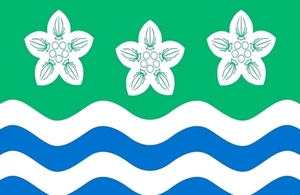Historic counties day celebrated in the heart of government
Eric Pickles raises flag of Cumberland to celebrate historic counties day

Cumberland flag
Local Government Secretary Eric Pickles raised the flag of Cumberland today outside his department’s headquarters in Westminster to celebrate Historic County Flags Day and the important role ancient shires continue to play in the nation’s cultural heritage.
Great Britain’s traditional counties date back over a thousand years of history, but were sidelined by Whitehall and municipal bureaucrats in recent decades. This includes the restructuring by Edward Heath’s government in 1965 and 1972.
By contrast, this government is championing local communities continuing to cherish and celebrate such traditional ties and community spirit. The law was changed by Parliament to make it easier to fly flags without a permit from the council – these new freedoms include flying the Cumberland flag.
Cumberland is a historic county of Great Britain dating from the 12th century. The first record of ‘Cumberland’ was in 945. But in 1974, the administrative council was combined with parts of Lancashire and the West Riding of Yorkshire to form part of the new county of Cumbria. However, the traditional county still lives on and is most famously associated with the Cumberland sausage, the HMS Cumberland and Cumberland County Cricket Club.
Eric Pickles, Secretary of State for Communities and Local Government, said:
Great Britain’s counties continue to form an important part of our cultural and local identity in this country and many people remain deeply attached to their home county. This sense of pride and shared identity is one of the things that binds communities together.
Peter Boyce, Chairman of the Association of British Counties, said:
People’s affinity for their county runs deep. Historic counties provide a living link to past generations who trod the same ground and nurtured the same loyalties as today’s Britons. They speak to us of the wonderful diversity of Great Britain, each possessing their own distinctive history, landscapes, traditions, dialects and building styles.
Charles Ashburner, Chief Executive of the Flag Institute, said:
The traditional counties of Great Britain are rich in history, yet inclusive of all of parts of society. These areas have survived modern administrative boundary changes and are enjoying an impressive resurgence. Flags have been the ultimate symbols of identity throughout history and they remain so today. So it is fitting to see the government flying the Cumberland flag today.
Further information
This is part of a series of steps to champion Great Britain’s local and national identities. The department recently launched a new initiative to support the ‘tapestry’ of traditional English counties being displayed on street and road signs. The government also published a new online interactive map of England’s county boundaries.
Planning rules have been changed to allow for councils to put up boundary signs marking traditional English counties – including the likes of Cumberland, Huntingdonshire, Westmorland and Middlesex. The government has also proposed changes to highways regulations to allow traditional county names to appear on boundary road signs.
The government has previously changed Whitehall rules to allow local and county flags to be flown without planning permission, and supported the Flag Institute in encouraging a new wave of county and community flags to be designed and flown by local communities.